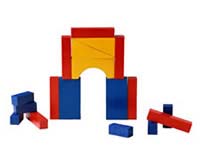Another nanobrick in the wall

Nanocubes could make polymer chemistry child’s play <br>© PhotoDisc <br>
Chemists make the world’s smallest building blocks.
US researchers have made the world’s smallest building blocks. The nanocubes are just a millionth of a millimetre (a nanometre) across1. Stacked like bricks, they could make up a range of materials with useful properties such as light emission or electrical conduction.
Many chemists are currently trying to develop molecular-scale construction kits in which the individual components are single molecules to provide the polymers of the future. Conventional polymers are chainlike molecules. These entangle to form plastics ranging from soft polyethylene to hard polystyrene.
Chemists can exert some influence over the properties of the bulk plastic by altering the shape and composition of the molecular chains. But they have little control over how the chains weave together.
Richard Laine and colleagues at the University of Michigan in Ann Arbor want to replace chains with bricks. Their molecular units are silicon and oxygen atoms linked into a cube-shaped framework with a silicon at each corner.
The researchers connect the cubes by their corners – each corner silicon has a ’spare’ bond to which other chemical groups can be attached.
Similar materials have been prepared previously using corner linkers made from chainlike hydrocarbons. Like cubic octupi with eight arms, these are of limited practical value because they decompose quite easily when heated, and form messy glass-like solids instead of well-ordered crystals with the cubes stacked precisely.
Laine’s team address this problem by replacing the loose, chain-like linker arms with stiff, stubby arms: compact aromatic molecules derived from benzene. These should make the resulting materials more stable and rigid.
For example, the nanocubes make a curable resin that can withstand heating above 500 oC in air. And by appending different molecular groups to the short benzene-like arms, the researchers have made a material that conducts electricity, which might be used in polymer-based light-emitting diodes for display devices. A third kind of cubic molecule emits green light and could be useful in sensors and displays.
References
- Tamaki, R., Tamaki, Y., Asuncion, M. Z., Choi, J. & Laine, R. M. Octa(aminophenyl)silsesquioxane as a nanoconstruction site. Journal of the American Chemical Society, 123, 12416 – 12417, (2001).
Media Contact
More Information:
http://www.nature.com/nsu/011220/011220-6.htmlAll latest news from the category: Life Sciences and Chemistry
Articles and reports from the Life Sciences and chemistry area deal with applied and basic research into modern biology, chemistry and human medicine.
Valuable information can be found on a range of life sciences fields including bacteriology, biochemistry, bionics, bioinformatics, biophysics, biotechnology, genetics, geobotany, human biology, marine biology, microbiology, molecular biology, cellular biology, zoology, bioinorganic chemistry, microchemistry and environmental chemistry.
Newest articles

Innovative 3D printed scaffolds offer new hope for bone healing
Researchers at the Institute for Bioengineering of Catalonia have developed novel 3D printed PLA-CaP scaffolds that promote blood vessel formation, ensuring better healing and regeneration of bone tissue. Bone is…

The surprising role of gut infection in Alzheimer’s disease
ASU- and Banner Alzheimer’s Institute-led study implicates link between a common virus and the disease, which travels from the gut to the brain and may be a target for antiviral…

Molecular gardening: New enzymes discovered for protein modification pruning
How deubiquitinases USP53 and USP54 cleave long polyubiquitin chains and how the former is linked to liver disease in children. Deubiquitinases (DUBs) are enzymes used by cells to trim protein…



